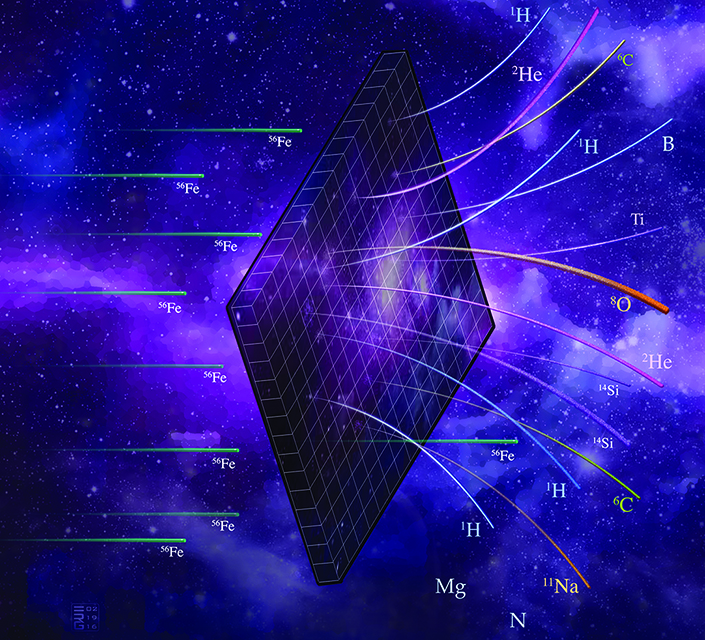Team creates ground-based model simulating effects of space radiation

Image: College of Science
Two years ago, Jeff Chancellor put a promising 15-year private-sector career in space radiation research and risk assessment on hold to concentrate full-time on finishing his Ph.D. at Texas A&M University. Although he may have taken a professional leave of absence, Chancellor never left behind the job of protecting NASA’s astronaut corps — an understandably personal mission, considering that his wife, Serena Auñón-Chancellor, is a member.
“I was a program manager working with NASA involved in radiation risk assessment and management, and I decided to give the Ph.D. one more try,” said Chancellor, Texas A&M Class of ’17. “A friend of mine was a professor at Texas A&M, and I had started working with him for a year or two before enrolling full-time in 2015. When he left, I asked Dr. [Donald] Naugle for recommendations, and he directed me toward Helmut Katzgraber and his computational physics group.”
One small step for man, one giant leap for mankind — or more accurately, the safety of future astronauts following in the late Neil Armstrong’s galactic footsteps, thanks to new research by Katzgraber’s group published last week on arXiv.org that has the potential to revolutionize materials research and biological experiments related to space travel.
Using well-established physics principles, Monte Carlo simulations and state-of-the-art supercomputing and data-analysis technology at both Texas A&M High Performance Research Computing and the Texas Advanced Computing Center (TACC), the Texas A&M-led team produced a model that simulates the highly complex space radiation environment and delivers results that stack up data point for data point in comparison to publicly available radiation-dose-related information obtained from three past NASA missions: Shuttle MIR, the International Space Station and Orion’s recent Exploration Flight Test Mission (EFT-1).
“What we have done is used well-versed, fundamental nuclear science principles combined with high-performance computing and shown that you can selectively degrade a heavy ion beam so that the emerging field actually mimics the space radiation environment found inside of these space vehicles — something that has never been done before and has not been utilized yet,” Chancellor told an audience assembled Jun. 9 in Texas A&M’s Interdisciplinary Life Sciences Building for a two-day Research Computing Week symposium. “Our approach is the first time that a true ground-based analog can be applied to mild studies of biological models for human health outcomes but also to evaluate satellite and orbiting hardware to RAD-hard test their capabilities.”
Chancellor says existing space radiation studies using mono-energetic, single-ion beams and mice as test subjects are problematic on two analog-related fronts — biological and environmental, neither of which accurately reflect the extremes found in space. While mice are considered a model organism for many research purposes, Chancellor notes they do not accurately approximate human physiology. For starters, they are not nearly wide enough to capture most of the dose from a proton, let alone all the higher energy particles present in the multi-ion, multi-frequency space environment.
Furthermore, Chancellor says such studies have shortcoming when attempting to describe the actual environment and medium considered. He takes issue with just a few manuscripts published in the past year indicating that astronauts are going to die of cardiac failure, suffer severe cognitive impairments caused by the galactic cosmic ray (GCR) spectrum or, most recently, come back from Mars with increased rates of cancer and reduced to babbling idiots, courtesy of space radiation.
“Each one of these studies has only used a single-ion, single-radiation source representing a very small percentage of the actual radiation field distribution,” Chancellor said. “They aren’t necessarily bad studies; they’re simply all based on analogs that do not mimic the environments they’re testing and biological models that are not like humans.”
Chancellor emphasizes that radiobiology studies on the effects GCR radiation are of paramount importance to space exploration in tandem with solar particle events (SPE), a second, more intense type of indirect ionizing radiation that astronaut crews are exposed to, often without warning. While Chancellor views SPEs as the bigger threat, he describes GCRs as the arch-nemesis of space radiation research, both because they include every ion in the periodic table at a wide spectrum of energies and because they are extremely difficult to shield. In fact, shielding can make the intravehicular (IVA) dose much worse.
“Although solar particle events can mostly be shielded, shielding for the galactic cosmic ray threat can actually be worse than it is by not shielding,” Chancellor said. “Much of it is such a high energy, it will go through your body without really causing too much biological impact. If you shield it, you slow it down, increasing the interaction with critical tissues or creating lower-energy spallation products and neutrons that could have the potential to be biologically devastating.”

